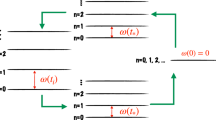Abstract
The notion of adiabatic evolution or adiabatic process is an important theoretical concept, which occurs at several places in Physics. The main feature of this concept is that although the process is very slow, global changes can take place without local changes. Adiabaticity is at the border between dynamics and statics. This concept was introduced by Boltzmann in Classical Mechanics through the notion of adiabatic invariants. In Thermodynamics adiabatic processes play an important role. In Quan tum Mechanics, if the state of the system is an eigenfunction ψ(t o) for the eigenvalue e(t o) at t = t o, then in the adiabatic limit the state of the system at time t = t 1 is an eigenfunction ψ(t 1) for the eigenvalue e(t 1), provided the energy-level e(t) remains isolated during the time-interval [t 0,t 1]. Even if H(t o) = H(t 1), the eigenfunction ψ(t 1) is generally different from ψ(t o) by a phase which can be decomposed into a dynamical phase related to the energy-level e(t) and a geometric phase related to the spectral subspaces visited during the adiabatic process. This is the fundamental observation of Berry 1 which gave rise to extensive developments during the last ten years2,3,4.
Access this chapter
Tax calculation will be finalised at checkout
Purchases are for personal use only
Preview
Unable to display preview. Download preview PDF.
Similar content being viewed by others
References
M.V. Berry, “Quantal phase factors accompanying adiabatic changes,” Proc.Roy.Soc.Lond.A 392: 45 (1984).
A. Shapere and F. Wilczek, “Geometric Phases in Physics”, World Scientific, Singapore, New Jersey, London, Hong Kong (1989).
J.W. Zwanziger, M. Koenig and A. Pines, Berry’s phase, Ann. Rev. Phys. Chem. ,41, 601 (1990).
C.A. Mead, The geometric phase in molecular systems, Rev.Mod. Phys. ,64, 51 (1992).
M. Born and V. Fock, Beweis des Adiabatensatzes, Zeit.f.Phys. ,51, 165 (1928).
T. Kato, On the adiabatic theorem of quantum mechanics, J. Phys. Soc. Japan,5 ,435 (1950).
L.M. Garrido, Generalized adiabatic invariance, J. Math. Phys. ,5, 335 (1964).
T. Kato, “Perturbation theory for linear operators”, Springer Berlin, Heidelberg, New-York (1966).
S.G. Krein, “Linear differential equations in Banach spaces”, Providence, R.I.: Transl. Math.Mon. 29 (1971).
J.E. Avron, R. Seiler and L.G. Yaffe, Adiabatic theorems and applications to the quantum Hall effect, Comm. Math. Phys. ,110, 33 (1987).
A. Joye and C.-E. Pfister, Full asymptotic expansion of transition probabilities in the adiabatic limit, J. Phys. A ,24, 753 (1991).
A. Joye and C.-E. Pfister, Superadiabatic evolution and adiabatic transition probability between two non-degenerate levels isolated in the spectrum, J. Math. Phys. ,34, 454 (1993).
A. Joye, H. Kunz and C.-E. Pfister, Exponential decay and geometric aspect of transition probabilities in the adiabatic limit, Ann. Phys. ,208, 299 (1991).
A. Joye and C.-E. Pfister, Exponentially small adiabatic invariant for the Schrödinger equation, Comm. Math. Phys. ,140, 15 (1991).
A. Martinez, Precise exponential estimates in adiabatic theory, Preprint (1993).
V. Jaksic and J. Segert, Exponential approach to the adiabatic limit and the Landau-Zener formula, Rev. Math. Phys. ,4, 529 (1992).
G. Nenciu, Linear adiabatic theory. Exponential estimates, Comm. Math. Phys. ,152, 479 (1993).
J. Sjöstrand, Remarque sur des projecteurs adiabatiques du point de vue pseudodifférentiel Preprint (1993).
A. Joye and C.-E. Pfister, Non-abelian geometric effect in quantum adiabatic transitions, Phys. Rev. A to appear (1993).
J.-T. Hwang and P. Pechukas, The adiabatic theorem in the complex plane and the semi-classical calculation of non-adiabatic transition amplitudes, J. Chem. Phys. ,67, 4640 (1977).
M.V. Berry, Geometric amplitude factors in adiabatic quantum transitions, Proc. Roy. Soc.London A ,430, 405 (1990).
J.W. Zwanziger, S.P. Rucker and G.C. Chingas, Measuring the geometric component of the transition probability in a two-level system, Phys. Rev. A ,43, 323 (1991).
A. Joye and C.-E. Pfister, Absence of geometrical correction to the Landau-Zener formula, Phys. Lett. A ,169, 62 (1992).
A. Joye, Proof of the Landau-Zener formula, Asymptotic Analysis to appear (1993).
A. Joye and C.-E. Pfister, Semi-classical asymptotics beyond all orders for simple scattering systems, Preprint (1993).
A. Joye, Non-trivial prefactors in adiabatic transition probabilities induced by high order com plex degeneracies J. Phys. A to appear (1993).
M.V. Berry and R. Lim, Universal transition prefactors derived by superadiabatic renormaliza- tion, Preprint (1993).
A. Joye, G. Mileti and C.-E. Pfister, Interferences in adiabatic transition probabilities mediated by Stokes lines, Phys. Rev. A 44, 4280 (1991).
Author information
Authors and Affiliations
Editor information
Editors and Affiliations
Rights and permissions
Copyright information
© 1994 Springer Science+Business Media New York
About this chapter
Cite this chapter
Joye, A., Pfister, CE. (1994). Quantum Adiabatic Evolution. In: Fannes, M., Maes, C., Verbeure, A. (eds) On Three Levels. NATO ASI Series, vol 324. Springer, Boston, MA. https://doi.org/10.1007/978-1-4615-2460-1_13
Download citation
DOI: https://doi.org/10.1007/978-1-4615-2460-1_13
Publisher Name: Springer, Boston, MA
Print ISBN: 978-1-4613-6047-6
Online ISBN: 978-1-4615-2460-1
eBook Packages: Springer Book Archive



